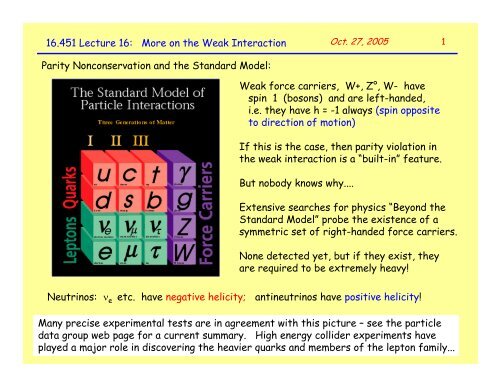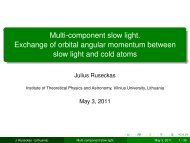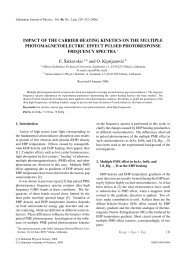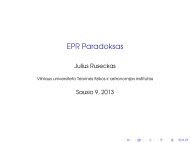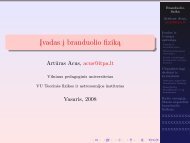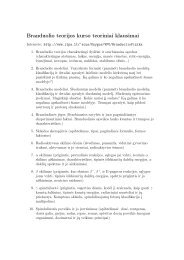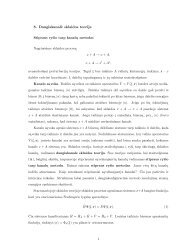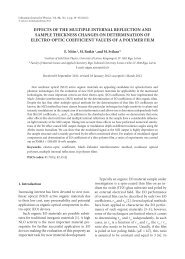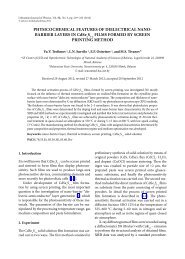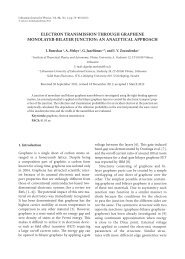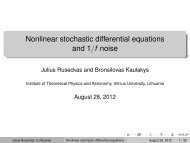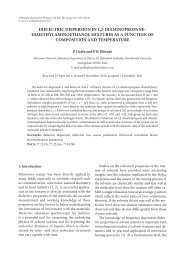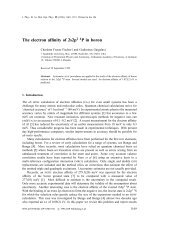Weak force carriers, W+, Z°, W- have spin 1
Weak force carriers, W+, Z°, W- have spin 1
Weak force carriers, W+, Z°, W- have spin 1
You also want an ePaper? Increase the reach of your titles
YUMPU automatically turns print PDFs into web optimized ePapers that Google loves.
16.451 Lecture 16: More on the <strong>Weak</strong> Interaction Oct. 27, 2005<br />
1<br />
Parity Nonconservation and the Standard Model:<br />
<strong>Weak</strong> <strong>force</strong> <strong>carriers</strong>, <strong>W+</strong>, Z°, W- <strong>have</strong><br />
<strong>spin</strong> 1 (bosons) and are left-handed,<br />
i.e. they <strong>have</strong> h = -1 always (<strong>spin</strong> opposite<br />
to direction of motion)<br />
If this is the case, then parity violation in<br />
the weak interaction is a “built-in” feature.<br />
But nobody knows why....<br />
Extensive searches for physics “Beyond the<br />
Standard Model” probe the existence of a<br />
symmetric set of right-handed <strong>force</strong> <strong>carriers</strong>.<br />
None detected yet, but if they exist, they<br />
are required to be extremely heavy!<br />
Neutrinos: ν e etc. <strong>have</strong> negative helicity; antineutrinos <strong>have</strong> positive helicity!<br />
Many precise experimental tests are in agreement with this picture – see the particle<br />
data group web page for a current summary. High energy collider experiments <strong>have</strong><br />
played a major role in discovering the heavier quarks and members of the lepton family...
How do we know that the weak interaction model is correct?<br />
2<br />
The picture of short-range, heavy charged<br />
<strong>force</strong> <strong>carriers</strong> gives a mechanism for nuclear<br />
beta decay that is consistent with older theories<br />
and experimental data.<br />
.. but if the W- only travels 0.002 fm at the speed<br />
of light, how do we know it is there? ……<br />
The neutral weak <strong>force</strong> carrier Z 0 is not required to explain beta decay, but is predicted<br />
to be a ‘heavy cousin’ of the photon, and the mediator of ‘neutral’ weak interactions –<br />
something that was not foreseen prior to the development of the current “electroweak”<br />
interaction theory by Glashow, Weinberg & Salaam – Nobel prize 1984.<br />
http://nobelprize.org/physics/laureates/1984/index.html<br />
Immediate consequences: e.g. parity violating (PV) electron scattering, now a standard<br />
tool for nuclear and particle physics (e.g. Q weak experiment: http://www.jlab.org/qweak/ )<br />
e<br />
e<br />
Z 0<br />
q<br />
q<br />
e<br />
<br />
s ( + )<br />
p<br />
σ ( + ) −σ<br />
( −)<br />
PV A Q GeV O Q<br />
σ( + ) + σ( −)<br />
−5 2 2 4<br />
: = ≅ − 10 ( ) + ( )
Direct evidence: creation of weak <strong>force</strong> <strong>carriers</strong> in colliding beam experiments<br />
3<br />
consider first a fixed-target experiment: extra kinetic energy in the beam is<br />
“wasted” rather than used for new particle production, since momentum has to be<br />
conserved (forward direction)<br />
p <br />
before<br />
after<br />
beam, total energy E fixed target, mass M new particle, mass M* > M<br />
minimum energy to produce M* corresponds to zero kinetic energy in the center<br />
of momentum frame:<br />
before<br />
after<br />
total 3 momentum = 0<br />
total energy E* = M* at threshold<br />
write down total 4-momentum in both lab and CM frames:<br />
lab: Pμ = <br />
( piE , ( + M))<br />
CM: P ′ μ = (0, iE*)
Now work out how much beam energy is needed in the lab:<br />
4<br />
lab<br />
CMS<br />
TRICK: length 2 of a 4 vector is invariant!!!<br />
P<br />
( P′<br />
)<br />
2 2<br />
=<br />
2 2 2<br />
⇒ p − ( E+ M) = −( E*)<br />
for m
CERN Accelerator Complex – 27 km long, under the city of Geneva, Switzerland!<br />
5<br />
several international collaborations built<br />
sensitive “calorimeter” and tracking<br />
detectors to record final state particles<br />
produced in high energy e+ e- collsions to<br />
search for new particles at LEP (now<br />
decommissioned to be replaced by the LHC<br />
or “Large Hadron Collider”)<br />
event from OPAL - Canadian group<br />
e+e- <strong>W+</strong>W- many particles!
Particle Data Group: cross section for e+e- annihilation at high energy<br />
6<br />
• resonance peaks for production of neutral particles – meson resonances seen<br />
at lower energy. All of these <strong>have</strong> J = 1, negative parity (recall pion has J = 0)<br />
1 1<br />
ρ = ( uu − dd) T = 1 ω = ( uu + dd ), T = 0<br />
2 2<br />
φ = ss J / ψ = cc ϒ = bb<br />
Z boson,<br />
discovered<br />
1983, CERN<br />
Total center of mass energy (GeV)
Close up of Z resonance peak gives the mass of the Z and the number of neutrinos!<br />
7<br />
peak at E cm<br />
= M Z<br />
= 91.2 GeV<br />
(N = 3 looks pretty good!)<br />
Fit gives N = 2.994 +/- 0.012 neutrino types!
And FINALLY, a quick word about SNO:<br />
8<br />
Sudbury Neutrino Observatory: http://www.sno.phy.queensu.ca/<br />
ν<br />
• SNO was built over a decade starting<br />
in the late 1980’s at a cost of ~ $100M<br />
to solve a long-standing problem in the<br />
observed deficit of neutrinos coming<br />
from the sun.<br />
?<br />
• A classic radiochemical experiment by Ray<br />
Davis et al carried out in a gold mine in<br />
South Dakota using the reaction:<br />
37<br />
Cl + ν → Ar + e<br />
e<br />
37<br />
−<br />
Earth<br />
had reproducibly detected only about 1/3<br />
of the expected number of neutrinos of<br />
solar origin. What was wrong???<br />
Prior to SNO, several other solar neutrino experiments were constructed and in<br />
operation world wide, e.g. the Kamiokande detector in Japan, SAGE and GALLEX<br />
detectors in Europe ... all had slightly different energy sensitivities and operated<br />
using different reactions to detect the neutrinos, but all found a discrepancy in the<br />
solar flux!
Calculated neutrino flux from fusion reactions in the sun, J. Bahcall et. al<br />
9<br />
Energy thresholds of various detectors are shown:<br />
Ref: Williams, section 14.7
All detectors, including SNO, show a deficit of electron neutrinos from the sun: 10
SNO – a unique D 2 O Cerenkov detector that can “see” all neutrino types<br />
11<br />
4700’ underground in the Creighton nickel mine in Sudbury, Canada, to suppress background<br />
from cosmic ray muons, etc:<br />
acrylic vessel holds<br />
1000 tonnes of heavy<br />
water, D 2<br />
O that makes<br />
an ideal detector for<br />
neutrinos.<br />
20” diameter photomultiplier<br />
tubes looking<br />
inward detect Cerenkov<br />
light when a neutrino<br />
interacts in the water<br />
Neutrino candidate event:<br />
Cerenkov “ring” on one side<br />
of the detector with nothing<br />
entering from the other side.
Neutrino detection mechanisms in heavy water:<br />
12<br />
1. “Charged current” mechanism:<br />
ν e<br />
+ d → p + p + e<br />
−<br />
(electron produces Cerenkov<br />
light in the water tank)<br />
2. “Neutral current” mechanism:<br />
ν + d → n + p +<br />
ν<br />
resulting neutron can be captured in<br />
a salt solution, and resulting γ-rays,<br />
which hit electrons in the water,<br />
again produce Cerenkov light that is<br />
picked up in the PMT’s<br />
Ratio of 1 : 2 gives the ratio of electron-type to total neutrinos from the sun!
SNO published results: http://www.sno.phy.queensu.ca/sno/publications.html<br />
13<br />
= 1.76<br />
±<br />
0.05 ±<br />
0.09⋅10<br />
6<br />
cm<br />
−2<br />
sec<br />
−1<br />
electron-neutrinos only<br />
Φ NC<br />
=<br />
5.09<br />
Φ CC<br />
1<br />
+ 0.44<br />
− .43<br />
+ 0.46<br />
−0.43<br />
6<br />
−2<br />
0 ⋅10<br />
cm sec<br />
−<br />
all neutrino types<br />
ν<br />
e<br />
Ratio: = 0. 35<br />
ν e + ν μ + ντ<br />
Significance of the SNO<br />
result: first experiment to<br />
“see what happened” by<br />
measuring all neutrino types<br />
Interpretation:<br />
• the total number of neutrinos is consistent with expectations from the solar model.<br />
• only electron-type neutrinos are produced in solar fusion reactions<br />
• 2/3 of these must be turning into other neutrino types (μ, τ) before reaching earth!<br />
Unavoidable conclusion: neutrinos must <strong>have</strong> a small but<br />
finite rest mass! (next question: how big is it?)
Neutrino masses and mixing: (see, e.g. http://www.sns.ias.edu/~jnb/ )<br />
14<br />
The theory of neutrino mixing gets complicated very quickly, but in a nutshell,<br />
the observation of “neutrino oscillations” sets limits on the mass-difference Δm 2<br />
and the mixing angle θ, e.g. for only two neutrino types, one could write:<br />
v e<br />
( t = 0) = sinθ v1 + cosθ<br />
v<br />
Then as time evolves, with the masses of 1 and 2 being different, the observed<br />
“neutrino state” will be a different linear combination of 1 and 2 that depends on<br />
the parameters Δm 2 and sin 2 θ . Combined data from all experiments can be used to place<br />
limits on the mixing parameters.... so far, the favoured situation looks like this:<br />
2
The SNO result is an incredible achievement for physics and Canada<br />
15<br />
http://www.nserc.ca/news/2003/p031124.htm<br />
It wasn’t easy! For a few years,<br />
the subatomic research community<br />
almost went broke trying to pay for<br />
SNO .... but it was worth it!<br />
SAP visits SNO as chair of<br />
NSERC GSC, 1997 – borrows<br />
$3M from NSERC to pay for<br />
construction cost overrun....


